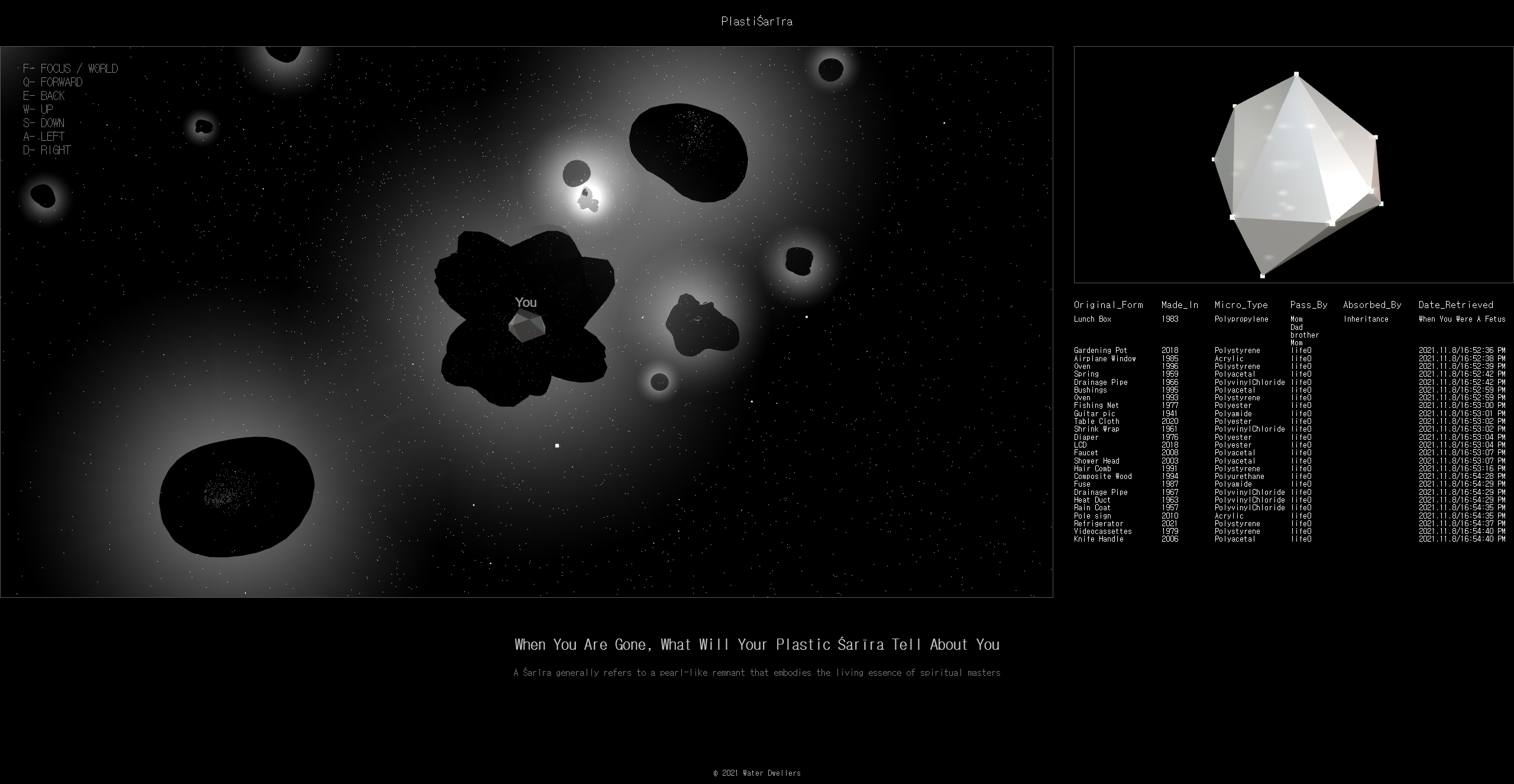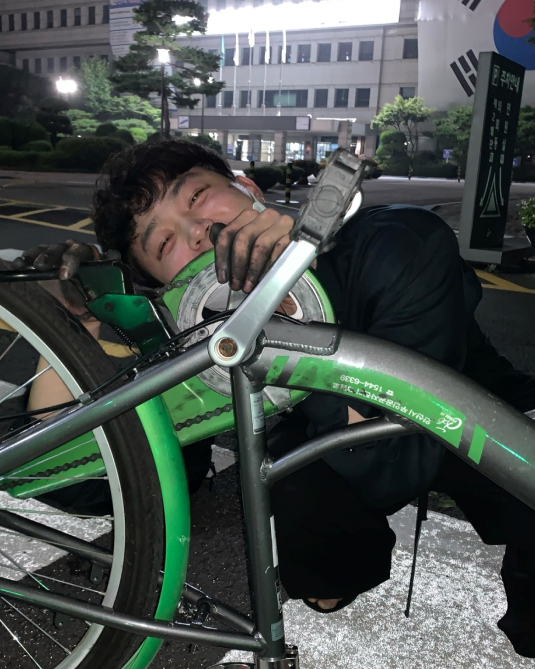미세 플라스틱은 북극, 몽골리아 산간 지방의 강, 그리고 생물들이 숨 쉬는 공기 중에도 있으며 심지어 우리 몸 안에도 있습니다. 주위 환경을 넘어, 플라스틱은 인류세를 거슬러가고 있는 모든 생물들의 구성요소가 되고 있습니다.
Microplastics can travel through the ocean to the North Pole, to remote rivers in Mongolia, into the air and ultimately inside our bodies. Therefore, plastics have not only become a major part of our environment, but also our basic component.
불교에서 사리는 “공덕 많은 스님이 돌아가신 후 남기시는 구슬”로 신성시 여겨집니다. 하지만 “플라스틱 사리”는 지구에서 존재만 하더라도 모든 생물들에게서 나올 것이라 예상됩니다. “공덕”이 아닌, 주위환경과 행해진 모든 “교류”의 유산입니다. 이러한 플라스틱 사리의 보편성이야말로 인간들 또한 자신이 만든 인공환경의 영향에서 예외대상이 아님을 조명합니다.
미세 플라스틱은 일종의 “메타 데이터”로서 이들이 거쳐온 동시대 생물, 무생물, 그리고 환경의 정보를 축적합니다. 인위적, 자연적 환경과 우리를 연결하는 부식되지 않는 이 매개체는 신체가 사라졌을 때 우리를 어떻게 그려낼까요?
This work imagines microplastics as a new type of Śarīra. Sarīra are stone-like Buddhist relics, purportedly found amongst the cremated ashes of Buddhist spiritual masters. They are commonly mystified into manifestations of good deeds and are considered to be produced only by monks. However, we believe this new type of śarīra, the plastic śarīra, will soon be left by every living creature on the planet, stowing the data of each organism, microbe and inanimate structure the microplastics have passed through. They will not be interpreted as the result of good deeds, but the accumulation of every interaction had, with the artificial/natural environment.
Microplastics will therefore be defined as “meta data”, sharing a glimpse of their every interaction. What will these durable, non-corrosive mediums that connect us with our artificial/natural environment, tell about us when our bodies disappear?

크롬(Chrome) 브라우저 이용을 권장합니다. For the best experience, we recommend using the Chrome browser.
플라스틱과 미세플라스틱의 해양오염에 대하여 조사하던 중 “플라스티스피어”에 대하여 알게 되었습니다. 플라스티스피어는 plastic(플라스틱)과 sphere(공간)가 결합되어 자연에 버려진 플라스틱에 적응하여 살 수 있도록 진화한 생태계를 뜻합니다.
While researching micro plastics and their effects on the ocean, we found a concept called the “Plastisphere”. The plastisphere is a term used to refer to ecosystems that have evolved to live in human-made plastic environments.
플라스티스피어는 몇가지의 문제를 일으킬 수 있습니다. 일차적으로 콜로레와 각종 질병들을 유발하는 바이러스들이 붙을 수 있다는 점입니다. 둘째는 미생물을 포함한 각종 외래종을 다른 생태계로 옮기는 역할을 합니다.
Plastispheres can potentially cause several problems. The first being that cholera and other disease related viruses are prone to stick to a plastisphere. The second problem is that the plastisphere relocates invasive microbes to other environments.
앞서 언급한 문제점들에서 플라스티스피어가 하나의 것과 다른 것을 연결해주는 “매체”의 역할을 하고 있다는 점에서 동일합니다. 플라스티스피어들이 해양 뿐만 아니라, 먹이사슬과 공기, 등을 통해 지구를 떠돌아다닌다고 상상해보면, 이들이 만들어내고 있는 것은 전지구적인 연결망이라고 생각합니다.
These problems show that the plastisphere acts as a medium that connects distinct things. If one can imagine the plastisphere not only in the ocean but also in the air and our food chain, what the plastisphere is truly constructing is a global network that connects organisms on earth.
플라스티스피어는 개별적인 미세플라스틱으로 구성되어있습니다. 이러한 미세플라스틱은 쉽게 분해되지 않으며 사라지지 않습니다. 미세플라스틱이 오랜시간 세계를 배회하며 수집한 미생물, 박테리아, 바이러스 같은 유기체 정보부터, 햇빛의 세기, 파도의 강도, 이들을 삼킨 생물과 자연계의 정보까지 수집할지도 모릅니다.
궁극적으로는 생물체의 몸은 지층처럼 이러한 미세 플라스틱을 축적할 것이라고 생각합니다. 따라서 우리 팀은 인공적 환경과 관계 맺으며 외부적 영향(미세플라스틱)을 몸 안에 축적하고 있는 존재로서의 의미를 찾고자 하였습니다. 이를 달성하기 위해 우리는 생물 체내 축적될 미세플라스틱들을 불교의 ‘사리’의 형태로 은유하게 되었습니다.
사리는 오랜시간 수행한 공덕의 결과물이자, 스님이 주위환경과 맺은 한평생 관계를 보여줄 수 있는 신체적 증거물로 볼 수 있습니다. 또한 과학적으로 사리의 성분들을 분석한 바, 신체 외부의 요소들로 구성되었다는 주장도 있습니다. 따라서 우리는 “체내 축적”, “유기적인 관계의 증거”, “유산”이라는 사리의 키워드들로 본 작품을 풀어가게 되었습니다.
Plastispheres are each composed of microplastics and we believe that they will eventually end up within us. Thus we wanted to explore what it means to be a being that accumulates micro plastics inside their body as a result of interacting with their artificial environment. In developing the ideas behind this concept we used the concept of ‘śarīra’ (Buddhist relics occasionally found amongst the cremated ashes of spiritual masters) as a metaphor and the keywords “body accumulation”, “evidence of organic relationship” and “heritage”.











